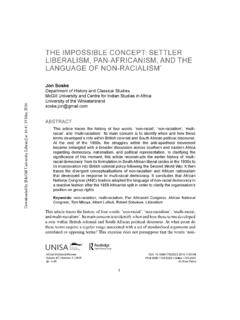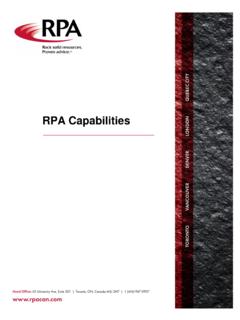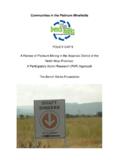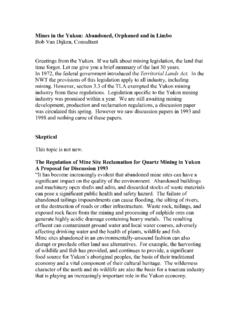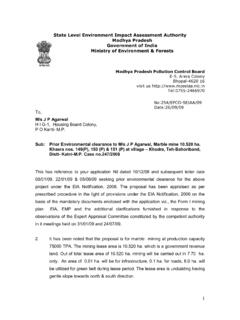Transcription of CHAPTER 1 HISTORY OF THE GA MAWELA …
1 CHAPTER 1 HISTORY OF THE GA MAWELA community LOCATION The farm St George 2 JT, which is part of a greater area known traditionally as Ga MAWELA , is located in the Greater Sekhukhune District Municipality (GSDM). The District consists of five Local Municipalities, namely Groblersdal, Marble Hall and Tubatse, Fetakgomo and Makhuduthamaga, previously spreading over both the Mpumalanga and the Limpopo provinces, but now consolidated under the Limpopo Province in accordance with proclamation No. 422 dated 27 December 2005. Ga MAWELA is situated in the Klein Dwars River valley, known traditionally as Molototsi. The Dwars River ( Moletsi ), is itself a tributary of the Steelpoort ( Tubatse ) River, which is a major tributary of the Olifants ( Lepelle ) River.
2 The Dwars River follows the outlay of one of the richest mineral reefs in the world the so-called Eastern Limb of the Bushveld Igneous Complex with valuable deposits of chrome and platinum group metals (platinum, rhodium, palladium), and is the site of major new mining developments. The subsidiary of Anglo American plc, know as Anglo Platinum, is at an advanced stage of the planning of the der Brochen Mine, which will impact on a number of farms in the Dwars River Valley, including the farm St George. There are a number of other mining related developments in the locality, which have been the driving force behind the recent expansion of the towns of Steelpoort, Burgersfort, Ohrigstad and Lydenburg. These towns are located approximately 300 kilometres from the economic hub of the Gauteng Province.
3 Adjacent to these towns are the impoverished settlements of the former Lebowa homeland , also known as the Kingdom of Sekhukhune , which has been an historical labour sending area for the Gauteng economy. The settlements of GaSekhukhune include a complex mix of traditional villages, with a HISTORY as long as the occupation of the area by the BaPedi and other ethnic groups, and other settlements created as a result of the mass forced removals of communities living on white farms in terms of the apartheid policy. The Ga MAWELA community is typical of many of the communities removed from farms in the Lydenburg District of the former Transvaal Province in the period between the 1950s and 1970s . The members of the community are scattered among various settlements and tribal authorities, including Maseven (Magolego), Ngwaabe (Rantho), GaMasha (Masha Nkotwane), Strydkraal (Masha), Mare-Ngwaritsi (Phetla), Molepane (Sekwati), Tafelkop (Matsepe) and the town of Jane Furse.
4 Some members of the community have established homes in the townships of Gauteng Province, but have retained cultural and familial ties to the community . The livelihoods of the members of the community are typical of population of the Greater Sekhukhune District Municipality, as reflected in recent studies conducted by the municipality for the purposes of its Integrated Development Plan (IDP), and it 2025 Development Strategy. The following section outlines the historical use of the land by the community , its governance systems, and process of land dispossession, resulting in the scattering of members of the community in the GaSekhukhune area. HISTORY OF THE community The Ga MAWELA community is one of many groups that moved into the area known as the Lydenburg district in previous centuries, migrating between different places depending on external factors such as climate, conflicts and even wars.
5 According to the oral HISTORY of the community , the Bakone Ba Mankge group moved into area known as Ga MAWELA in the early 1800s, and established itself under its Chief ( kgoshi ) Marobele, the father of Mapale who succeeded Marobele as a chief. Marobele is buried on the farm Richmond, adjacent to St George (Figure 1). The community was comprised of a number of clans (dikgoro), including Mashilangoako, Lelengoa, Leshaba, Maredi and Magane. The Ga MAWELA area was divided up among these clans, and the affairs of the community were administered accordingly. The land was allocated by the tribal council (moshate) under the leadership of the Bakone ba Mankge, and these practices continued until the final dispossession of the community .
6 The white farmers gave some recognition to this situation in earlier days, and would consult with the kgoshi on certain decisions on land use, including the allocation of fields to new households moving on to the farm from outside. The moshate practiced a system of traditional law under which matters were first dealt with at clan level, and then referred to the moshate, which would refer unresolved matters further to the Kingdom of Sekhukhune for adjudication. The community was known for its powers as rainmakers, and was consulted on such matters by the Kingdom of Sekhukhune. There are a number of sites of sacred importance to the community on the farm St George, including pools and caves, some of which remain secret to this day.
7 The relationships between the Bakone ba Mankge group and the other makgoshi in the wider area were held together by bonds of marriage between houses, and these bonds remain strong to this day, despite the effects of dispossession on these communities as a whole. The Ga MAWELA community lived on the land by grazing their cattle, goats and sheep in the valleys and mountains of the area. Although the last recorded incidence of cattle disease in the valley was in the beginning of the last century, the communities managed this threat by grazing animals on the top of mountain ranges in the area during the hottest period in the year. They also ploughed their fields twice in the year, producing, maize, sorghum (mabele), wheat, potatoes, sweet potatoes and varieties of indigenous beans.
8 The community also kept pigs and chickens on the farm. There are remains on the farm of the kraals used by the community to keep livestock, as well as the places used for grinding grains (malwala). The social lives of the members of the community was typical of communities in the area, celebrating marriages, coming of age (initiation), births, rain and harvest. Events were also held to mourn deaths. A number of rituals were conducted, including grave cleaning and intercessions for good luck and for keeping the ancestors alive within the community . Initiation was carried out in the farm and the remains of the initiation sites (mphato) can be seen on the farm. These initiation practices were used to transfer life-skills from generation to generation and create a sense of belonging among the male and female members of the community .
9 The initiation ceremonies at Ga MAWELA were praised in the whole of Bokone (south of the Steelpoort River) and Sekhukhune area (north of the Steelpoort River) as there were no casualties. The traditional healers looking after the initiates were also used by most of the chiefs in the area to strengthen their communities against enemies and ill fortune. The Mankge community was respected for their knowledge of various ailments and traditional medicines. People came to the community seeking remedies obtained in the mountains and valleys of the area which provide a diverse habitat for a number of medicinal plants and wild fruits. The Ga MAWELA community was self sufficient in many ways and there was active trading amongst communities in the area, for tools, craft materials and medicinal herbs.
10 The valley has a rare type of river reed for making grain baskets and the community weaved for themselves and to trade with other communities in the area. Due to the secure water sources in the valley, the community was able to trade surpluses of wheat and other crops in the broader Sekhukhune area. As was typical of the communities living in the area before occupation of the land by white settlers, the community built furrows along the valleys to irrigate their crops. The last white farmer (van den Berg) was still using the old furrow system to channel water from the various streams to the storage dams for irrigation. There are a number of perennial steams on the property, which has provided for the water needs of the community even during dry periods.


